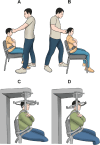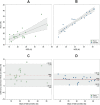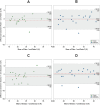Validation of a Novel device for Assessing Neck Muscle Strength
- PMID: 40510875
- PMCID: PMC12159756
- DOI: 10.33393/aop.2025.3476
Validation of a Novel device for Assessing Neck Muscle Strength
Abstract
Background: The Neuromuscular Cranio-Cervical Device (NOD) was originally designed to evaluate Cranio-Cervical Flexion Test performance but can also be used as a handheld dynamometer for testing other muscle groups, including neck muscle strength. It offers a potential alternative to the Multi-Cervical Unit (MCU), a fixed dynamometer, more closely aligned with isokinetic dynamometry, the gold standard. However, its validity and reliability need to be established. This study aimed to evaluate concurrent validity compared to the MCU and inter- and intra-rater reliability of the NOD for measuring neck flexion and extension muscle strength.
Methods: Twenty participants were assessed for neck flexion/extension strength whilst in a seated position, with the measurements repeated over three sessions. Concurrent validity was assessed by comparing NOD measurements to the MCU using Pearson correlation coefficients, and reliability was determined using Intraclass Correlation Coefficients (ICCs).
Results: Concurrent validity was strong for extension (r = 0.954) but lower for flexion (r = 0.705), indicating some variability in flexion measurements. Inter-rater reliability was good to excellent for both flexion (ICC = 0.931) and extension (ICC = 0.896). Intra-rater reliability for extension was good to excellent (ICC = 0.893), while flexion ranged from moderate to excellent (ICC = 0.844).
Conclusions: The NOD is a valid tool, particularly for extension measurements, although further refinement of testing is needed to improve the accuracy for flexion strength measurements. It is also reliable for both extension and flexion, showing promise as a practical, affordable, portable tool with real-time feedback for the assessment of neck muscle strength in clinical settings.
Keywords: Concurrent Validity; Handheld Dynamometer; Inter-rater Reliability; Intra-rater Reliability; Multi-Cervical Unit; Neck Muscle Strength.
© 2025 The Authors.
Conflict of interest statement
Conflict of Interest: The authors declare no conflict of interest
Figures



Similar articles
-
A clinical test to assess isometric cervical strength in chronic whiplash associated disorder (WAD): a reliability study.BMC Musculoskelet Disord. 2022 Aug 1;23(1):736. doi: 10.1186/s12891-022-05703-0. BMC Musculoskelet Disord. 2022. PMID: 35915421 Free PMC article.
-
Evaluating the Intra-Rater and Inter-Rater Reliability of Fixed Tension Scale Instrumentation for Determining Isometric Neck Strength.Int J Exerc Sci. 2021 Apr 1;14(3):563-577. doi: 10.70252/FOOV8378. eCollection 2021. Int J Exerc Sci. 2021. PMID: 34055163 Free PMC article.
-
Test-retest reliability and concurrent validity of knee extensor strength measured by a novel device incorporated into a weight stack machine vs. handheld and isokinetic dynamometry.PLoS One. 2024 May 22;19(5):e0301872. doi: 10.1371/journal.pone.0301872. eCollection 2024. PLoS One. 2024. PMID: 38776288 Free PMC article.
-
Reliability and validity of knee extensor strength measurements using a portable dynamometer anchoring system in a supine position.BMC Musculoskelet Disord. 2019 Jul 8;20(1):320. doi: 10.1186/s12891-019-2703-0. BMC Musculoskelet Disord. 2019. PMID: 31286912 Free PMC article.
-
Reliability and Validity of Clinical Tests for Measuring Strength or Endurance of Cervical Muscles: A Systematic Review and Meta-analysis.Arch Phys Med Rehabil. 2021 Jun;102(6):1210-1227. doi: 10.1016/j.apmr.2020.11.018. Epub 2020 Dec 28. Arch Phys Med Rehabil. 2021. PMID: 33383030
References
-
- Enoka RM. Fifth edition ed. Champaign, IL:: Human Kinetics;; 2015. Neuromechanics of human movement. - DOI
-
- Versteegh T, Beaudet D, Greenbaum M, Hellyer L, Tritton A, Walton D. Evaluating the reliability of a novel neck-strength assessment protocol for healthy adults using self-generated resistance with a hand-held dynamometer. Physiother Can. 2015;67(1):58–64. doi: 10.3138/ptc.2013-66. - DOI - PMC - PubMed
-
- Falla D, Lindstrøm R, Rechter L, Boudreau S, Petzke F. Effectiveness of an 8-week exercise programme on pain and specificity of neck muscle activity in patients with chronic neck pain: a randomized controlled study. Eur J Pain. 2013;17(10):1517–1528. doi: 10.1002/j.1532-2149.2013.00321.x. - DOI - PubMed
LinkOut - more resources
Full Text Sources

